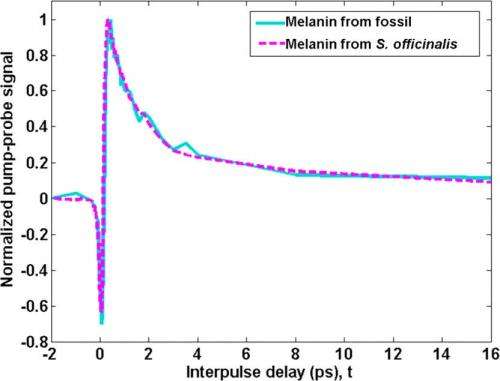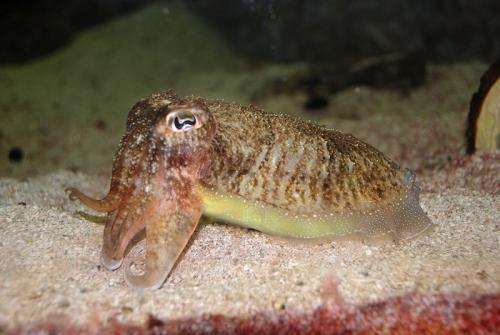June 3, 2013 feature
Melanin from Jurassic-era mollusk could lead to new tool for cancer diagnosis

(Phys.org) —In a world where things seem to change overnight, melanin seems to stay essentially the same for more than 160 million years, a new study has found. Melanin is the biological pigment that determines an animal's color, and is currently not very well understood. In the new study, scientists have found that a type of melanin called eumelanin from a Jurassic-era mollusk produces a signature when optically excited that is nearly identical to that of the optically excited eumelanin from its modern counterpart, Sepia officinalis, or the common cuttlefish. Because melanin survives so long, an analysis of the melanin from old cancerous tissue samples could give researchers a useful tool for predicting the spread of melanoma skin cancer in humans.
The researchers, Mary Jane Simpson, et al., led by Professor Warren S. Warren at Duke University in Durham, North Carolina, have published their paper on their analysis of Jurassic-aged eumelanin in a recent issue of The Journal of Physical Chemistry Letters.
"Melanoma is a particularly bad cancer if it metastasizes," Warren told Phys.org. "Unfortunately, the 'gold standard' of conventional diagnostic techniques (essentially, excision followed by pathology) does not do a very good job of predicting which diagnosed cancers are likely to spread. So, how do you fix a bad gold standard for a bad disease?
"The best answer is retrospective studies—looking at decades-old specimens from patients, where you know the outcome—and trying to find systematic differences. That is impossible with most pathology methods because the tissue degrades. Our results show that it is possible with melanin-based diagnostics, since the melanin easily survives that long."
The researchers explain that human skin has two types of melanin, eumelanin and pheomelanin. The distribution of these two types assists in the diagnosis of melanoma skin cancer. One way to identify the types of melanin and their distribution in a given sample is to use a molecular imaging technique called pump-probe microscopy. Basically, an ultrafast laser pulse is first used to "pump," or optically excite, the molecules. Then after a short time delay, one or more follow-up pulses are emitted to "probe" the molecules. By measuring how the probe pulses are absorbed or reflected by the molecules, researchers can obtain a pump-probe signature that reveals information on the molecules' excitation decay process. Since eumelanin and pheomelanin have different pump-probe signatures, this technique enables scientists to distinguish between them.

Here, the researchers compared the pump-probe signatures of the eumelanin from the ink sack of a Jurassic-era cephalopod (an ancient molluscan marine animal) with that of a modern cephalopod, the common cuttlefish. (Despite its name, cuttlefish are mollusks, not fish.) Although the Jurassic-era cephalopod is 162 million years older than its modern counterpart, the eumelanin pump-probe signatures of the two animals are essentially identical. This finding shows that eumelanin is extremely stable, and could potentially permit researchers to image archived tissue samples from deceased cancer patients and uncover more information than could be obtained through more traditional methods that analyze other, less stable chemicals.
The researchers pointed out that they did find some variations in the eumelanin signatures from the two mollusks. However, they could trace these variations to the larger iron content in the ancient eumelanin compared with the modern sample. Eumelanin from the common cuttlefish is normally bound to a variety of transition metals such as iron, copper, and manganese, but washing the eumelanin with the solid acid EDTA removes the majority of the bound metals. When the researchers washed the ancient eumelanin with EDTA, its signature closely matched that of the modern, mostly iron-free eumelanin.
Because iron affects the pump-probe signature of eumelanin, the microscopy technique could also potentially enable researchers to approximate the iron content of a sample. For example, pigmented human tissue often exhibits a wide range of pump-probe signatures, and some of the variation may be due to metal ion binding by the melanin. In the future, pathologists may use this knowledge to their advantage when investigating the molecular composition of eumelanin samples.
More information: Mary Jane Simpson, et al. "Pump-Probe Microscopic Imaging of Jurassic-Aged Eumelanin." The Journal of Physical Chemistry Letters. 2013, 4, 1924-1927. DOI: 10.1021/jz4008036
Journal information: Journal of Physical Chemistry Letters
© 2013 Phys.org. All rights reserved.
















